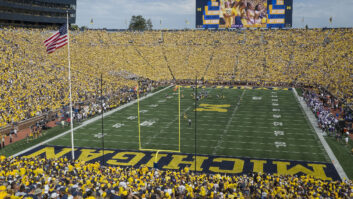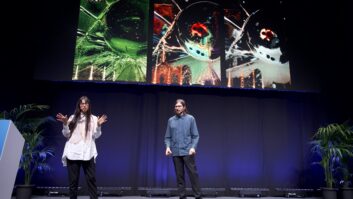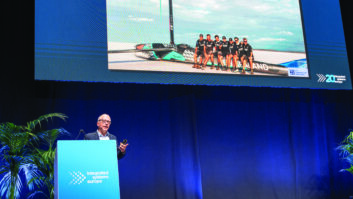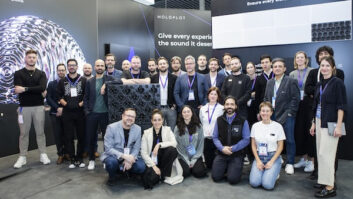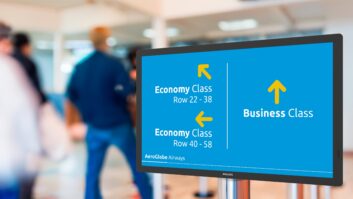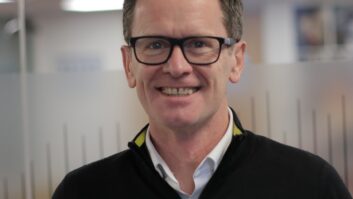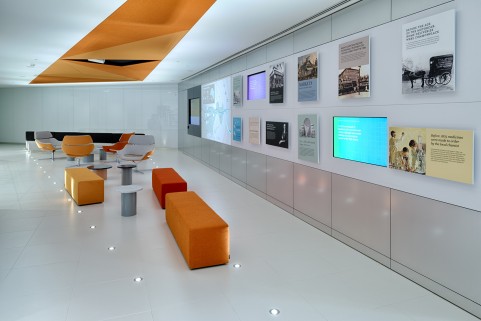
Having reinvigorated its consumer healthcare division, the pharmaceutical giant wanted a facility that would deliver a quantum leap in its brands’ retail performance. Paddy Baker reports on the conception and delivery of a major project that won a Teamwork Award at our recent InstallAwards.
Retailers, and the manufacturers that supply them, are on a never-ending quest to understand how shoppers behave in-store. How should products be best organised on shelves? What is it about the packaging that makes shoppers more likely to pick up this product rather than that one?
Glaxo SmithKline, as well as being a major player in prescription medicines, also has a number of consumer healthcare brands, such as Sensodyne toothpaste, Panadol painkillers and Nicorette nicotine replacement – all with a strong element of science behind them. To improve the performance of these brands at retail, and to improve its working relationships with retailers, the company decided to create the Consumer Healthcare Shopper Science Lab – a facility that uses audiovisual technology to facilitate and accelerate the study of shopper behaviour.
Wider experience
“Our vision is to be first and best in the FMCH – fast-moving consumer healthcare – category,” explains GSK IT director Russell Barrow. “So we wanted to create a point of difference, not a point of parity with our competitors. The starting point was not to look at the consumer goods industry, but look at what other industries do that we could repurpose. So on the visualisation side, it’s the VR technology that we’ve found in oil and gas, and automotive – taking all that thinking, all the underlying software, the technology, the work processes – and using that to bring to life the shopping environment.”
By using a virtual shop environment in place of a full-size mock-up of a supermarket shelf or a pharmacy counter, GSK can get feedback on shopper reactions to potential new products much more quickly and easily – speeding the product development process and saving on costs – because, for instance, no dummy packaging has to be printed. Similarly, shelf layouts can be modified and tested immediately.
“We couldn’t tell you that this shape of bottle will increase sales by 1%, or that people will pay 5p more for this product, but we can tell you – particularly with comparative studies – that this shelf layout works much better than that one,” explains GSK’s Crispin Haywood, director of the Shopper Science Lab.
The 10,000sqft Lab has been designed to be brand-neutral, so that visiting shoppers do not know they are visiting a GSK facility. Additionally, the Lab hosts visiting retailers as well as GSK’s own staff, and can be branded with retailers’ logos and colours. In fact, says Barrow, 50% of the benefit of the Lab is related to insight on shopper behaviour, and 50% to improved collaboration with retailers – for instance by having them on site to observe their own customers in action.
The centrepiece of the Lab is the world’s largest seamless touchscreen (5.32m wide by 2.55m high), which provides full 3D visualisation of retail environments. The size of the display was determined by the fact that it had to simulate either four bays of supermarket shelving with header boards, or a pharmacy counter with the products in front of the viewer and a display behind the pharmacist.
“To be able to read the barcodes and labels on the products, we did a whole lot of work with the client setting up pack photos and then projecting them, and then came to the conclusion that we needed 42 pixels per inch for the display,” says Blair Parkin, managing director of audiovisual consultancy Visual Acuity, which was responsible for the conceptual design of the Lab. This resolution may sound low, but it is sufficient given that the display is representing a supermarket shelf some distance from the shopper. When the shopper touches the screen to select a product, the displayed image immediately zooms in on the pack – calling up the product shot from a database on the fly. “There is also a practical limitation [on image resolution] when generating the images in real time on the computer and then displaying them.”
It’s important that the screen does respond in real time, explains Parkin. “Some of the participants are wearing an eye tracker so you can see how they interact with the shelf visually – what they look at first, how they approach it and so on. If the graphics are not linked in real time, then all those readings are potentially affected.”
The facility also uses bespoke skin and facial biometric tools to detect shoppers’ unconscious reactions – which makes it important to have a good camera system. In the research control room, feeds from fixed cameras in all the research areas can be viewed; additionally, live recordings can be paused, rewound and annotated.
Bespoke wall solution
A projection solution was chosen for reasons of brightness, but, says Parkin, “We tried to buy what we wanted on the market, but no-one would do it.” Therefore a project management approach was required. Display wall manufacturer Cyviz was responsible for the display element (projectiondesign projectors) and organised the manufacturing of the screen, and Visual Acuity “got everyone to play nicely” to ensure that the touch element, by U-Touch, was integrated. “Then the touchscreen has to behave as an input device for the real-time graphics computer, and this was done by Red Dot Square.”

Another noteworthy aspect of the project, says Parkin, is that “it’s a truly networked-based AV and IT installation – one network, with everything running digitally – audio, video, data visualisations, consumer monitoring over CCTV – all streamed into an IP-based control, editing and storage package, Milestone. There were certainly some challenges around that – audio and video arrive at different times once you digitise them. It’s easy to manage because everything flies around the building on the network, but it was tough to synchronise.”
The majority of the AV design and installation was carried out by integrator Insight Presentation Systems, led by technical director Mathew Cook. It was Insight’s job, he says, to take the conceptual designs created by Visual Acuity and turn them into full project designs. In some areas of the project, the consultant suggested particular products, but more generally it gave performance specifications which Insight had to meet.
While it’s most apparent in the collaboration room, the entire building was conceived a wire-free environment – using Clickshare, Sharp Big Pad and iPad applications for control and interaction with everything. However, says Cook, a DVI/DisplayPort cable was put in one location at the insistence of Neil Hartstone of GSK, as a safeguard against any audio-video sync issues with the wireless kit.
On the audio side, Visual Acuity recommended QSC’s Q-Sys DSP system, and Cook and his team found themselves in agreement with this choice. “There were going to be audio racks and amplifiers in the various different public areas of the Lab, and they needed to be connected by a network. There simply wasn’t the budget to commission a bespoke audio network with specialist switches — we needed to be able to have the audio management platform simply ‘see’ all of the audio infrastructure by connecting it to the existing AV network. Q-Sys allowed us to do that.”
Project verdicts
Cook reflects: “Overall the project went very, very well.” That’s not to say that it was plain sailing, though. “It’s always difficult on these large builds to get an honest picture from the main contractor regarding when they will really be ready for us. We probably got onto site earlier than we should have done – perhaps by a month – but we were told things were ready when they weren’t.”
Cook had anticipated this, however. “Rather than having a big team hit the project in a short period of time I had a fairly small team working alongside the other contractors, getting what they could done, and they could give me constant updates on where the site was rather than how it was perceived to be.” Most of the time there were four or five people on site working under Cook, rising to eight at the busiest times.
There was a degree of slippage on the project: originally due to open in May 2013, the facility actually began its work in October. Most of this delay, says Parkin, was due to lease issues that deferred the start of construction.
He also looks back fondly on the Shopper Science Lab. “It was a terribly good-natured project. Everyone wanted it to succeed. It was slightly odd – there was an absurdly short timescale, but with very passionate people, and everyone caught the passion and we made it happen across the whole project.”
That’s not to say it was entirely free from tension. “In every project with a high degree of esoteric design and functional design, and different consultants representing those things, there’s always tension between form and function. This project was no different in that regard, but what made it easier was that we were simulating real-world environments.”
Lighting decisions took a lot of hard work, he says, but this is par for the course: “On almost every project, lighting is one of the most challenging areas, because you’re crossing disciplines between theatrical and effects lighting, building architectural lighting and safety lighting, and they’re normally represented by three different sets of people. If you don’t work hard, you end up with three separate systems, which no client wants on a project like this.”
Overall, Parkin says the project was “ambitious in every possible way. The only way you can achieve something like that is if the project team are equally ambitious, but the key thing was it had executive backing to the hilt because it was looking to be a huge business generator, and that’s proved to be true.”
Barrow elaborates: “The real proof of the Lab has been in its adoption. Global marketing teams can make more decisions in an afternoon than they could previously in a couple of months.” I guess if you want to be the leader in fast-moving consumer healthcare, it’s important to be able to move fast.
Installed
Video
Cyviz bespoke projection screen
U-Touch Touch Frame
Barco (projectiondesign) projectors
Sony SCNEP580 IP PTZ cameras
Sharp BigPad 80in touchscreens
Samsung ME46, ME55 LCD displays
Christie DWU-550G WUXGA projectors
Milestone video software
Barco Clickshare units
Audio
QSC Q-Sys Core 500i DSP units
QSC CX602V amplifiers
QSC AD-C42T ceiling speakers
QSC AD-S32-T speakers
Shure MX202B/N ceiling misc
ClearOne Interact Pro conferencing system
Revolabs Executive HD wireless mic systems
Bose MA12 array speakers
Bose MB4 subwoofer
Control
AMX Enova DVX2155HD controllers
AMX NetLink NI-3100 and NI-2100 controllers
Apple iPads
AMX TPI-PRO interface
Iiyama 32in touchscreens
AMX Modero MVP-9000 touchpanel
www.amx.com
www.barco.com
www.clearone.com
www.cyviz.com
www.gsk.com
www.iiyama.com
www.milestone-system.com
www.pro.bose.com
www.pro.sony.eu
www.popewainwright.co.uk
www.qsc.com
www.reddotsquare.com
www.samsung.com/business
www.sharp.eu
www.shure.eu
www.u-touch.co.uk
